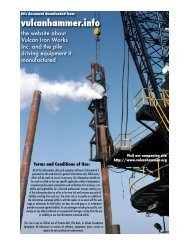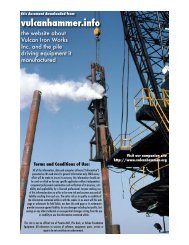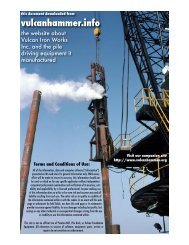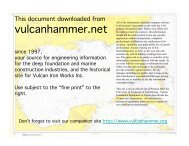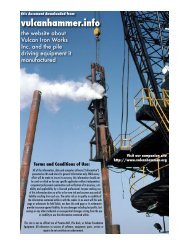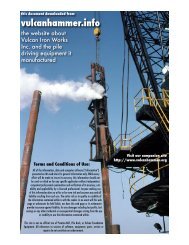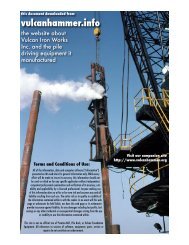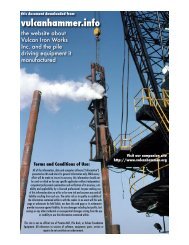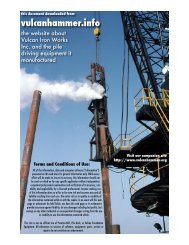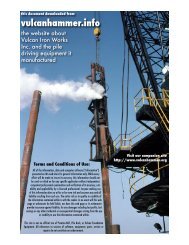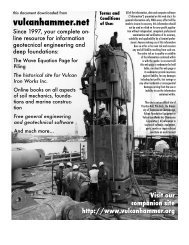Pile Hammers and Equipment - vulcanhammer.info
Pile Hammers and Equipment - vulcanhammer.info
Pile Hammers and Equipment - vulcanhammer.info
You also want an ePaper? Increase the reach of your titles
YUMPU automatically turns print PDFs into web optimized ePapers that Google loves.
Glen H. Barber, Sales ManagerL. B. Foster Company, <strong>Equipment</strong> Division, Pittsburgh, 173i 15108For presentation atAssociated <strong>Pile</strong> & Fitting Corp. PILETALK SeminarMiami Beach, Florida, March 1978IiitPGLEN BARBER has worked with piling for twenty years, starting on inspec-$ tion; he has supervised pile installation for C<strong>and</strong>ler-Rusche <strong>and</strong> for Fordf 1 Motor Co. He loitled 15. B. Fosfer as pile driver specialist zn 1970 <strong>and</strong> served6 in New Orleans artd Houston before ass~fming his present top management1%1: position at I*. B. Foster corporate headquarters.ii<strong>Pile</strong> drlving is perhaps one of the oldest forrns of heavy construction. Our/ i. distant ancestors probably beat a few sticks into the shoreline to tie up theirI 1 boats or to provide a means for reaching them in early Bible times. The! . builders <strong>and</strong> engineers of the day proved highly ingenious in the ways they,i. devised to set piling with various crude forms of drop hammers, which usedi. :. gravity as the source of energy. A number of the structures they erected areilstiU st<strong>and</strong>ing to this day.iThen, as now, soil was the greatest variable in the pile-soil-hammer cha<strong>info</strong>r support of structures over areas where adequate bearing material is at considerabledepth. The type of pile can be a choice; the hammer can be selectedIfor energy <strong>and</strong> characteristics. The soil is what is there <strong>and</strong> generally is notIwhat is desired; if it were ideal, piles would not be needed. Fortunately forthose of us who try to make a living in the foundation field there are a lot ofdifficult areas where soils are a problem.! Soils easily divide into cohesive-which have a clay base that binds the soilItogether-<strong>and</strong> non-cohesive-usually gravel or s<strong>and</strong>s with no binders holdingthe particles together.Cohesive clays can be dry <strong>and</strong> stiff, requiring strong blows to force a pileto bearing strata. Or they can be soft, permitting penetration under littleImore than the weight of the hammer.IGravels or coarse tofine s<strong>and</strong>s with little or no clay binders are classed asnon-cohesive soils. Douhle or d i f f e r e n t i a l - 1work we11 inThe vibratory drivers are especially efficient in highlyw&er bearina sob. B ~ u b s e ~ s a r ~ they rmay-nots - penetrate at-all. Some soils are mixtures of cohesive <strong>and</strong> noncohesive soils-me varvadensities <strong>and</strong> wau content of t h e soils make it difficult to apply any hard?7 <strong>and</strong> fast rulcuqadinoardinr! hammer selection <strong>and</strong> application.Knowledge of the characteristics <strong>and</strong> composition of the soil may beobtained through various methods. Consistency of cohesive deposits or therelative density of non-cohesive deposits can be determined <strong>and</strong> further classifiedby the results of a penetrometer test. This test, which involves no drillingfor samples, utilizes a device that is pushed or driven into the ground to measurethe soil's resistance to pcnetr3tiow.The most common <strong>and</strong> widely used test for indication of the consistencyor relative density of most soils is the St<strong>and</strong>ard Penetration Test (SPT). The
Fenergy is derived from both the weight of the falling ram anqcornpressedair or steam pushing it downward.-'T-ificantdifference between double-acting <strong>and</strong> differential-acting isthe rrianner <strong>and</strong> sequence of exhausting on the upward <strong>and</strong> downward strokeso m c l e . in the differential-acting hammer there is no drop from theentering prcSsure to the main effective pressure moving the piston on thedownward stroke.Double-acting <strong>and</strong> differential-acting hammers normally give better resultsin granular noncohesive soils or in soft clays. Used in proper soil conditionswith the right pile, almost twice the production can be obtained as with asingle-acting hammer.IWazW+Single-Acting Diesel <strong>Hammers</strong>: The single-acting diesel pile hammer operateson the same working principle as a two cycle diesel engine. The ram, or pistonas it is sornetirnes called, is lifted by a tripping device to a predeterminedheight <strong>and</strong> is autornatically released. The ram falls under its own weight <strong>and</strong>actu;ites the c m of the fuel pump which injects a measured amount of fuelinto a specially designed receptacle in the anvil. Continuing its downward fall,the ram closes the intakejexhaust ports <strong>and</strong> compresses the air in the cylinderahead of the ram. The cornpression of the trapped air tightens the anvil <strong>and</strong>drive cap against the top of the pile in preparation for the impacbblow. Thecompression also assists in starting the pile downward, Fig. I.The ram strikes the anvil <strong>and</strong> delivers its impact energy to the pile, drivingDIAGRAM-1 b the pile downward, Fig. 2. AS the ram impacts the anvil, the fuel is simul-I I I/22taneously atomized into the annular combustion chamber around the ramWORKING HOURS <strong>and</strong> the anvil. The hot compressed air ignites the air-fuel mixture, <strong>and</strong> thet resulting explosive force pushes the pile further into the soil <strong>and</strong> propels theram upward. The exp<strong>and</strong>ing gas in the cylinder is discharged when the risingram opens the intake/exhaust ports, Fig. 3.So0 .DlAGRA?I-2 AS the ram rises above the intakelexhaust ports, fresh air i's drawn intothe cylincler due to the negative pressure which is created. The fuel pump375250.1250/,/ - +/>A-W-/ //1.12 I-C/-can1 returns to its original position in preparation for injection of fuel on the/next stroke. The ram continues freely upward until arrested by gravity <strong>and</strong>AIR COOLED TYPEthen again begins its downward stroke for the next cycle, Fig. 4. The hammeris slopped hy disengaging the fuel purrlp for a short period to shut off theflow of fucl.Diesel pile harnrners are cooled either by water or air. The cooling systemiof a diesel hammer tleserves particular attention because o.f the close relationshi!?it has with the overall perfopance <strong>and</strong> life of the hammer. A watercooledhammer dissipates the heat generated by the combustion in the cylinderthrough evaporation of tlie water surrounding the cylinder in the waterI jacket.The air-cooled haninrer depcnds greatly upon the convection of the sur-WATER COO1 Fn TYPFi rounding air <strong>and</strong> there is a stronger tendency for the cylinder to becomet overheated. An overheating condition may cause the lubricants to lose theirviscosily or burn <strong>and</strong> the lubricution of the inside of thc cylinder becomesI unsatisfactory causing the compression rings to collapse. This results in loss;of con~pression, a decregsc in the generated blow <strong>and</strong> reduced striking force.hOverheating also causes pre-ignition of the fuel prior to the impact blow oftlie rani, which cushions the impact blow anti reduces the effectiveness of theclownw;lrd push of the explosive forc-e, tlrus udversely affecting the perform-I I/22 ance of the hammer. Diagrams 1-2 show the results of coniparativc test ofWORK1 NG HOURSair-cooled arid watcr2cooleci dicsel pile hamnlers ;~ftcr two hours of continuousoperation.,
WE I GHTSVIBRATING CASE -1 / CABLEStlic tall. ile~gt~t ot fall is tile maximum albwable stroke stat( .-.,,facturer. Rated energy of single-acting diLSel pile hammers rar "?he rom 9,000ft Ih to 298,000 ft Ib. They operate at 35 to 60 blows per mir.,Diesel hammers have certain advantages over air/steam hammers. They areoperated without auxiliary equipment such as air compressors or boilers. q ewei~ht of a diesel pile hammer is generally about 112 to 113 the weight of anairlsteam hammer having the same drivink energy. Thus, smaller capacitycranes may be eriiployed. . The design of the diesel hammer provides a presettingof the anvil <strong>and</strong> drive cap against the top of the pile which minimizesdamage to the pile head.Diesel hammers operate best in medium to hard dribing conditions on alltypes of piles. In soft ground conditions, the lower resistance does not forcethe ram to recoil sufficiently to permit the needed compression for ignitionto occur.Double-Acting Diesel <strong>Hammers</strong>: The double-acting diesel pile hammers orclosed end as it is sornetunes called, is similar to the single-acting diesel hammerin opera.tion. The double-acting, however, employs a bounce chamber 'above tlic ram, arid 011 the upstroke o! the ram the air is compressed betweentlie conrpression rings at the top of tlie ram <strong>and</strong> the enclosed top of the hammcr.The compressed air limits the upward travel of the ram <strong>and</strong> then adds tothe force of gravity to accelerate tlie ram downwards. It is this fo~ce of therapiil expansion of the compressed air on the ram, in addition to the force ofgravity, that results in increased ran1 velocity <strong>and</strong> the increased numher ofblows per minute. The mill weight of a double-acting hammer is approximatelytwice that of a single-acting diesel hammer of similar energy rating,while the height of stroke is approximately half that of the single-actinghammer.Rated energies of these hirnmers range from 8,000 to 80,000 ft Ib <strong>and</strong>speecl rangrs from 80 to 100 b!ows per ~iiinutc. Double-acting diesel hamniersare riiost effective in non-cohesive 2nd soft clay soils.IELECTRIC GENERATORVIaRATORY DRl VERiEXTRACTOR SYSTEMELECTRICAL TYPEVibratory <strong>Pile</strong> Driver: AU of the previously disciisszd pile driving hammershave one corninon denominator: i.e., they pound the pile into the ground.A little c~vera dccailc ago tlie vibratory type pile ciriv.er-extractor wasintrotlucerl to tlic Anierican pile driving industry. Instead of pounding thepile into the grounli, tlie hanirner installs them using vibration. Driving ratesin non-cohesive soils or1 non-displucernent type piles are up to eight timesfaster tIi31i ir~ipact type lia~iimrrs. <strong>Pile</strong> darnage is practically eliminated, sincethere is no impact.i\tlditional advantages of the vibratory type driver is that it does notrequire leatlers or guides but some units can be mounted to operate 011 lead&if rCqilircd. Thc vibratory driver operates much quieter than impact hammers<strong>and</strong> I)eco~nes an excellent extractor by applying substantial line pul! or tensionto tlic crane link. The vibration breaks the grip of the soil on the pile<strong>and</strong> the crane pulls tlie pile out.The vibratory driver-extractor has three main components: a vibratingcase which contains the rotating eccentric weights; a suspension system withvibration sulipl.essors; <strong>and</strong> a driving or extracting head with a hydraulic clamp.Electric vibratory units have electric motors mounted within the suspensionsystc.111, while hydraulic vibratory units have hydraulic drive motors mountedon 111e vibrating case. In both the electiic <strong>and</strong> hydraulic type vibratory unitstlie powrr source is external 2nd separate from the vibratory driver with thepower supplied to the rriotors by cables orhoses. Figs. 5 <strong>and</strong> 6 illustrate the
\VIBRATINGaCASE1h rECCENTR ICWE l GHTS 7REMOTE-CONTROL PENDANTHYDRAULIC POWER PACKIISUSPENSIONSYSTEMHOSESHYDRAULIC0 I LRESERVOIRIk. .....,,L" L..' .-.L.\..'.L d.1" JI~UILI~..IL .,U,Y."., "I. ..con~ponents of each called out.A simpiif~ed description of the working principle of a'v jry driverextractoris that electric or hydraulic motors rotate the eccentn-eights containedm the vibrating case at high speed. The eccentric weights, which areequal in welght, are rotated in opposite directions <strong>and</strong> only vertical vibrationis created in the v~bratlng case. The vibrat~on is transmitted undiminished tothe p~le through the hydraulic clamp of the driving or extracting head. Thevibration of the pile breaks the grip of the soil on the sides of the pile <strong>and</strong>also permits the soil at the tip of the pile to be readily displaced during driving.The vibration also loosens the pile for extraction. ,The vibrating case is isolated from the crane line by the suspension systemcontaining the vibration suppressors, so only the minimum of vibration istransmitted to the crane boom in either the driving or extracting mode ofoperation.The total effectiveness of a vibratory driver-extractor is dependent uponthe balanced inter-relationship of the performance factors inherent to a vibratoryunit. The inter-relationship of these factors may seem complicated, butit is quite similar to an impact type hammer where the ram weight, ramstroke, hammer speed <strong>and</strong> pile weight all affect the drlving results. The performancefactors common to a v~bratory driver-extractor are amplitudeeccentric moment, frequency, dynan~~c force, vibrating weight <strong>and</strong> non->vibrating weight.Amplitude is the amount of vertlcal movement of the plle produced bythe vibratory unit <strong>and</strong> is measured in inches. It is the direct result of theapplied force generated by the rotating eccentric weights. Plle penetrationrate is directly related to amplitude.Eccentric hloment of a vibratory driver is the value, expressed in inchpounds,equal to the weight of the eccentric multiplied by the distance fromthe center of rotation to the center of gravity of the eccentric times the totalnumber of eccentrics the unit uses. The rotating eccentrics generate thevibratory force which creates amplitude of vibration of the pile. Therefore,increasing eccentric moment will increase amplitude.Freorrcrlcy is the number of vertical movements or vibrations per minute.The velticd movement is created by the rotation of the eccentric weights.Each rotation of the eccentric weights causes one complete up <strong>and</strong> downmoverncnt of the pile. The number of vibrations per minute is the same as.he revolutions per minute of the eccentric weights.Dynamic Force, or centrifugal force as it is commonly referred to, is generatedby the rotating of the eccentric weights. The calculation of this force,in tons, is:VIBRATORY DRI VER/EXTRACTORSYSTEIYDynamic Force = M e n c v 2 x Eccentric Mom-(Tons) 70.4 x 106HYDRAULIC TYPEComparing the dynamic force of different vibratory hammers u applicableonly when the eccentric moments are equal.Vibraritlg Weight is the weight put into vibration which includes the vibratingcase, driving head ~ n the d pile itself. Non-vibrating weight is basically thesuspension system. Non-vibrating weight pushes down on the pile <strong>and</strong> aids indrivi~ig. Solne non-vibrating weight is helpful, but too much niakes a bulky,difficult-to-h<strong>and</strong>le unit.
0 IS 30 45 60 75 90 105 120 I35DYNknlC FORCE IN TONS0GRAPH NO. 1DETERMINATION OF REQUIRED DYNAlMIC FORCELocate the known total p~le length on the horizontal axis <strong>and</strong> project a line verticallyupwards until the diagonal line of the graph is intersected.After intersecting the diagonal line, project a horizontal line to the left verticalaxis of the graph. This will give the amplitude in tenths of an inch required todrive the pile.0 15 50 75 1W 125 150PILE LENGTH IN FEETGRAPH NO. 2DETERMINATION OF REQUIRED AMPLITUDEfI. i G;,uL~,~~3UII'VCI-2xi1-actor tiar~iniers are classitied Into ti ypes-highfrequency, rnedium frequency <strong>and</strong> low frequency. Iligh fr ncy drivers,also called "sonic" or "resonant" drivers, operate at a speed..Jrequency inthe range of 3,500 to 10,000 vibrations per minute. They generate amplitudetheve,rtical movernent of the pile tip-by actually exp<strong>and</strong>ing <strong>and</strong> contractingthe pile. Maximum amplitucle is achieved when the frequency of vibrationapproaches the resonant frequency of the pile material, hence, the name"resonant pile driver". High frequency vibratory drivers have had limited use ;<strong>and</strong> success. The large power requirements <strong>and</strong> high operating <strong>and</strong> maintenancecosts have restricted their conimerciai success.While high frequency drivers exp<strong>and</strong> <strong>and</strong> contract t'he pile, medium, <strong>and</strong>low frequcncy drivers move the whole pile as a rigid unit. However, despitethis sin~ilarity, medium <strong>and</strong> low frequency drivers do differ in basic designconcept. Vibratory force on a pile can be created two ways, i.e., rotatinglight eccentric weights at high frequency or by rotating heavier eccentricweights at low frequency.The low frequency driver has generally been the most successful. The frequencyrange of low frequency vibratory units, 400-1,500 vibrations per minute,covers the range of minimum frictional forces, medium frequency drivers,at 1,500-3,500 vibrations per minute, operate above the range of minimalfrictional forkcs. .krnplitude increases as frequency decreases because the pilecan move down farther before the rotating eccentrics pull it back upwards.Therefore, low frequency units can be expected to give higher penetrationrates since their amplitudes are higher.Generally, vlbralory drivers are most effective in non-cohesive soils <strong>and</strong>soniewhat less cffective in cohesive soils. In granular soils <strong>and</strong> s<strong>and</strong>s, thevibration easily forces tile pile downward. The effectiveness of a vibratorydriver is greatly enhanced if the soil water content is high as the water actsas a lubricant on the pile. In cohesive soils or ciays, the vibratory motionkeeps the soil from developing much of a grip on the pile <strong>and</strong> the largervibratory drivers are successful in forcing the pile tip to cut through.Tfie type of pile being driven also influences the effectiveness of a vibratorydriver-extractor. Displacement type piles with large tip areas such asclosed-end pipe, concrete or wood piles must move, or displace, the soil arelatively large distance to permit the pile's downward movement. Vibrationrnay riot be able to move the soil this far. However, with non-displacementtype piles, such as sheet piling, t1-sections, open-end pipe or caissons, thesoil particles rleed to move only a short distance to allow the pile to pass.There are no sct rules to determine where or when a vibratory driverwill be tlie most effective tool to use. They should definitely be consideredfor driving non-displacement piles in any soil <strong>and</strong> also, for any kind ofextraction job. Although displaccrnent piles have been <strong>and</strong> can be driven byvibratory tlrivers, these applications should be studied carefully.However, when it has been decided that a vibratory driver is the bestselection, it is possible to determine the size of the vibratory driver based onthe dynamic force <strong>and</strong> amplitude by utilizing graphs 1 <strong>and</strong> 2, if the "n" value(blow count) for the soil is known at the desired depth, the total length ofpile to be used <strong>and</strong> the weight of the pile per lineal foot. These charts arevalid for noncohesive soils where non-displacement type piles are to beinstalled.When the required dynainic force <strong>and</strong> amplitude are known from thegraph; a vibratory harnrner can be selectett that will produce these requirements.Most manufacturers <strong>and</strong> distributors make available the maximurndynaniic force <strong>and</strong> alnplitudc of their various size vibratory hammers.
LIC U ~ ~ I I I I C U equ~p~il~:ntI L acqu~s~tlonme:>" difference between job profit <strong>and</strong> loss.-<strong>Equipment</strong> Acquisitioncho~ce. i Ills decls~on so~nel~~~lksA contractor is faced wit11 many equipment acquisition choices. Cash purchases,various installmenl plans, rental plans, <strong>and</strong> a number of differentleases <strong>and</strong> loans arc available to contractors who want to acquire equipment.The question is: what financing alternative offers the most advantages fora certain piece of equipment on a particular project: The alternatives heremust be considered as carefully as those project variables which led to thechoice of equipment in the first place.Basically, in total dollars spent, the least costly method of financing apiece of equipment is the cash purchase; ,the most expensive is renting. But,there are other costs to consider: costs imposed by missed tax deferrals, <strong>and</strong>costs of lost profits from work missed due to lack of funds or bonding capacity,<strong>and</strong> costs of lost dollar value because of inflation.When a contractor weighs the alternatives, all costs must be figured in.A knowledge of the effects of each financing alternative on business ratios,bonding capacity, income tax, equipment salvage value kept or lost, <strong>and</strong> onfuture profitable projects is imperative.In some instances, a future cash-flow analysis will show a cash purchase tobe impossible. In other cases, business ratios <strong>and</strong> bonding needs necessitateleasing; in still othcrs. paying more per month in rental fees could be themost profitable method of acquis~tion.Let's discuss the advantages <strong>and</strong> disadvantages of buying, renting <strong>and</strong>leasingCash PurchasingThe advantages of outriglit purchase of equipment are many. It allows contractorsto do whatever they want with the equipment. It is not dependenton future income. It allows contractors to dispose of the equipment wheneverthey wish <strong>and</strong> earn profits from the transaction. Buying gives the contractorgreater freedom of choice. It allows using the equipment as collateral forcredit in future acquisitions. Lastly, the equipment's depreciation value,investment tax credit <strong>and</strong> repair allowance always belong to the contractor.Major disadvantages in buying equipment are also numerous. Cash purchasesfreeze large amounts of capital that might earn more. elsewhere. Ithurts business ratios <strong>and</strong> bonding capacity. Due to prevailing tax laws,the tendency is to keep a piece of equipment longer than is economicdlyfeasible. In addition, obsolescence often cuts down a machine's competitivevalue. And, inflation causes the contractor to pay'for the equipment in highvaluedollars, while it depreciates <strong>and</strong> earns income with dollars of less value.Renting <strong>Equipment</strong>There has been a!greater tendency during recent years for contractors torent equipment. Renting is, in effect, instant equipment; the contractor getswhat he needs, 'when <strong>and</strong> where he needs it quickly. And, rental firms areobliging by building up their heavy-duty inventories, offering more servicesthan ever before <strong>and</strong> exp<strong>and</strong>ing their product lines.Contractors are often not sure of what lies down the road, thus they dislike1IiIhave the money to buy. Others want to get out from undc ntenancecosts, between-job moves, <strong>and</strong> insurance. Renting may be the 7,.Paying more per month for a rented machine could be mu,,.iore profitablethan allowing it to sit rusting in the yard for half its useful life. Mostcontractors orlly own equipment they can keep working for :~t least 60 percentof its life. A popular rule of thi~mh most contractors follow is: rentequipment that will be used for less than one year.Other advantages in renting are: it can improve business ratios becausethere is no major capital expenditure; all rental payments are tax deductible;modern, efficient <strong>and</strong> well-maintained equipment is always available; contractorscan use specialized or high capacity equipment, <strong>and</strong> various modelswithout accumulating a parts inventory; <strong>and</strong> renting eliminates or drasticallyreduces storage costs, repair costs, <strong>and</strong> administrative overhead.In addition, inflaJion does not affect rental rates, cash flow can be plannedmore effectively through equipment rental, <strong>and</strong> rental allows contractorsgreater flexibility. Renting is also a hedge against losses on equipment O~SOlescence,<strong>and</strong> an aid in estimating <strong>and</strong> preparing bids.Most renters calculate rates on a monthly basis. Weekly rates run aboutone-third of monthly rates, <strong>and</strong> daily rates one-third of weekly rates. Numberof shifts the equipment will work, site conditions, <strong>and</strong> length of working.seasonall affect rental rates..Choosir~g tile best rental firm is also an important consideration.iThe bestorganizations have the foliowing qualifications:Itlidc ratlgc of equipment - Ex'perienced rental firms in the constructionbusiness have a tailor-made inventory to provide the types of equipmentneeded now.Quick Delivery - If a good rental firm doesn't have what is needed, itknows where to get it. And, Can get it fast.Trained Person,~cl - A good rental company has management, salesmen,<strong>and</strong> yardmen who are farniliar with the equipment. They can answer all yourquestions, which gives you help in choosing the right piece of equipment atthe best price.Corrlplerc Recordkeepirlg - Better agencies maintain an accurate historyof each piece of equipment, including total rental time, uptime <strong>and</strong> variouscost <strong>and</strong> ~naintenance figures.Corr~plctr Service Deparrrnerlt - When you rent a machine, it has to perfonnproperly. If there is a breakdown, you want the repairs made as quicklyas possible. Trained mechanics, a good parts inventory <strong>and</strong> emergency serviceall mean less downtime <strong>and</strong> better profits.Pickup <strong>and</strong> De1iver:y - Good rental firms deliver to the jobsite <strong>and</strong> pickup' the machine when you are done with it. This service is another time <strong>and</strong>money saver to you.Modern L'quipment - Top-notch rental firms dispose of old equipmentthrough sale or auction, maintaining a line of modern, efficient equipment.Conrracrs are Clear - A good rental contract spells out all terms in detail;repairs, maintenance, transportation, insurance <strong>and</strong> accidents are clarifiedbefore you sign.A final note to renting is the rental-purchase option (RPO) plan. Manycontractors favor this option because they can rent an unfamiliar machine<strong>and</strong> if it works well <strong>and</strong> they like it, most or all rental payments can beapplied to the purchase price. Most rental firms subtract a finance chargefro111 all payments <strong>and</strong> apply rhc rest io the purchase price; others apply aUof the first month's payment <strong>and</strong> declining amounts of further rentds; <strong>and</strong>
~easi. 9 ipmentLeasing provides the contractor with yet another alternate form of equipmentacquisition. Many hanks are willing to offer lease contracts. Distributorsare well equipped to put together a lease package; many major financecompanies are deeply into leasing construction equipment.Advantages in leasing are: leasing allows the contractor to pay for equipmentwith tomorrow's more inflated dollars; leasing conserves capital whenmoney is tight; leasing offers certain tax advantages (rentals paid on leasedequipment may be fully deductible operating expenses); leasing allowsgreater control over a contractor's expenses; <strong>and</strong> leaslng can help a contractorfind a way around budget Limitations.Lezsing offers the widest number of options available to contractorsacquiring equipment. It also offers the widest range of costs. Two major d~sadvantagesare: It usually prevents contractors from taking profits fromequipment salvage value, <strong>and</strong> leasing is often Inore expensive than borrowingto purchase.To- conclude, realizing profits by selecting the right pile hammer is theresult of two major decis~ons: choosing the right hammer for the lob <strong>and</strong>deciding on ;he best method of equipment acquisition. There are no hard<strong>and</strong> fast rules in making either choice, Each situation calls for individualevaluation based or1 all the variables discussed. There is no one hammer thatwill "do it all" <strong>and</strong> no one method of equipment acquisition that will assureprofitabd~ty.W



